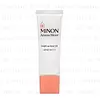What's inside
What's inside
 Key Ingredients
Key Ingredients

 Benefits
Benefits

 Concerns
Concerns

 Ingredients Side-by-side
Ingredients Side-by-side

Water
Skin ConditioningCyclopentasiloxane
EmollientTitanium Dioxide
Cosmetic ColorantDiphenylsiloxy Phenyl Trimethicone
Skin ConditioningPEG-9 Polydimethylsiloxyethyl Dimethicone
EmulsifyingOctyldodecyl Myristate
EmollientTriethylhexanoin
MaskingPentylene Glycol
Skin ConditioningButylene Glycol
HumectantCetyl PEG/PPG-10/1 Dimethicone
EmulsifyingDisteardimonium Hectorite
StabilisingTrimethylsiloxysilicate
EmollientLauroyl Lysine
Skin ConditioningVinyl Dimethicone/Methicone Silsesquioxane Crosspolymer
Zinc Chloride
AntimicrobialPotassium Hydroxide
BufferingStearic Acid
CleansingDipentaerythrityl Tri-Polyhydroxystearate
EmollientPhytosteryl/Octyldodecyl Lauroyl Glutamate
Skin ConditioningTribehenin
EmollientPhenoxyethanol
PreservativeVinyl Dimethicone/Lauryl Dimethicone Crosspolymer
Tocopherol
AntioxidantStearyl Glycyrrhetinate
Skin ConditioningMethicone
EmollientBifida Polysaccharide
HumectantPPG-12
Skin ConditioningSilica
AbrasiveLimnanthes Alba Seed Oil
Skin ConditioningCarnosine
Skin ConditioningTaurine
BufferingGlycerin
HumectantLysine Hcl
Skin ConditioningPolyquaternium-61
Skin ConditioningGlutamic Acid
HumectantGlycine
BufferingLeucine
Skin ConditioningHistidine Hcl
Skin ConditioningSerine
MaskingValine
MaskingTin Oxide
AbrasiveZinc Aspartate
Skin ConditioningThreonine
Alanine
MaskingIsoleucine
Skin ConditioningAllantoin
Skin ConditioningPhenylalanine
MaskingArginine
MaskingProline
Skin ConditioningTyrosine
MaskingAlginic Acid
Skin ConditioningDisodium Guanylate
EmollientTalc
AbrasiveDimethicone
EmollientBoron Nitride
AbsorbentCI 77492
Cosmetic ColorantWater, Cyclopentasiloxane, Titanium Dioxide, Diphenylsiloxy Phenyl Trimethicone, PEG-9 Polydimethylsiloxyethyl Dimethicone, Octyldodecyl Myristate, Triethylhexanoin, Pentylene Glycol, Butylene Glycol, Cetyl PEG/PPG-10/1 Dimethicone, Disteardimonium Hectorite, Trimethylsiloxysilicate, Lauroyl Lysine, Vinyl Dimethicone/Methicone Silsesquioxane Crosspolymer, Zinc Chloride, Potassium Hydroxide, Stearic Acid, Dipentaerythrityl Tri-Polyhydroxystearate, Phytosteryl/Octyldodecyl Lauroyl Glutamate, Tribehenin, Phenoxyethanol, Vinyl Dimethicone/Lauryl Dimethicone Crosspolymer, Tocopherol, Stearyl Glycyrrhetinate, Methicone, Bifida Polysaccharide, PPG-12, Silica, Limnanthes Alba Seed Oil, Carnosine, Taurine, Glycerin, Lysine Hcl, Polyquaternium-61, Glutamic Acid, Glycine, Leucine, Histidine Hcl, Serine, Valine, Tin Oxide, Zinc Aspartate, Threonine, Alanine, Isoleucine, Allantoin, Phenylalanine, Arginine, Proline, Tyrosine, Alginic Acid, Disodium Guanylate, Talc, Dimethicone, Boron Nitride, CI 77492
Water
Skin ConditioningCyclopentasiloxane
EmollientZinc Oxide
Cosmetic ColorantEthylhexyl Methoxycinnamate
UV AbsorberButylene Glycol
HumectantDiethylhexyl Succinate
EmollientPolymethylsilsesquioxane
Hydrated Silica
AbrasiveGlycerin
HumectantLauroyl Lysine
Skin ConditioningLauryl PEG-9 Polydimethylsiloxyethyl Dimethicone
Skin ConditioningDiethylamino Hydroxybenzoyl Hexyl Benzoate
UV FilterSodium Hyaluronate
HumectantAcrylates Copolymer
Hydrogen Dimethicone
Phenoxyethanol
PreservativeTriethoxysilylethyl Polydimethylsiloxyethyl Dimethicone
Skin ConditioningMethylparaben
PreservativeDisodium EDTA
Sodium Acetylated Hyaluronate
HumectantHydrolyzed Collagen
EmollientArginine
MaskingBis-Ethylhexyl Hydroxydimethoxy Benzylmalonate
AntioxidantWater, Cyclopentasiloxane, Zinc Oxide, Ethylhexyl Methoxycinnamate, Butylene Glycol, Diethylhexyl Succinate, Polymethylsilsesquioxane, Hydrated Silica, Glycerin, Lauroyl Lysine, Lauryl PEG-9 Polydimethylsiloxyethyl Dimethicone, Diethylamino Hydroxybenzoyl Hexyl Benzoate, Sodium Hyaluronate, Acrylates Copolymer, Hydrogen Dimethicone, Phenoxyethanol, Triethoxysilylethyl Polydimethylsiloxyethyl Dimethicone, Methylparaben, Disodium EDTA, Sodium Acetylated Hyaluronate, Hydrolyzed Collagen, Arginine, Bis-Ethylhexyl Hydroxydimethoxy Benzylmalonate
 Reviews
Reviews

Ingredients Explained
These ingredients are found in both products.
Ingredients higher up in an ingredient list are typically present in a larger amount.
Arginine is an amino acid that is important for human development. Your body uses is it to produce hair keratin and skin collagen.
As a cosmetic ingredient, Arginine has antioxidant properties and can also help repair damaged skin. This ingredient is derived either synthetically or from animals.
Arginine isn't fungal acne safe when used in the presence of other lipids (fats, fatty acids, oils, esters, etc). Oils and fats occur naturally within the skin, so take caution when using Arginine if you're prone to fungal acne.
Learn more about ArginineButylene Glycol (or BG) is used within cosmetic products for a few different reasons:
Overall, Butylene Glycol is a safe and well-rounded ingredient that works well with other ingredients.
Though this ingredient works well with most skin types, some people with sensitive skin may experience a reaction such as allergic rashes, closed comedones, or itchiness.
Learn more about Butylene GlycolCyclopentasiloxane, or D5, is a silicone used to improve texture of products and trap moisture.
D5 is considered lightweight and volatile. Volatile means it evaporates quickly after application. Once evaporated, D5 leaves a thin barrier that helps keep skin hydrated.
It is also an emollient. Emollients help soften the skin and prevent water loss. Silicones create a silky texture in products. D5 helps other ingredients become more spreadable.
Studies show D5 is safe to use in skincare products. We recommend speaking with a skincare professional if you have concerns.
Learn more about CyclopentasiloxaneGlycerin is already naturally found in your skin. It helps moisturize and protect your skin.
A study from 2016 found glycerin to be more effective as a humectant than AHAs and hyaluronic acid.
As a humectant, it helps the skin stay hydrated by pulling moisture to your skin. The low molecular weight of glycerin allows it to pull moisture into the deeper layers of your skin.
Hydrated skin improves your skin barrier; Your skin barrier helps protect against irritants and bacteria.
Glycerin has also been found to have antimicrobial and antiviral properties. Due to these properties, glycerin is often used in wound and burn treatments.
In cosmetics, glycerin is usually derived from plants such as soybean or palm. However, it can also be sourced from animals, such as tallow or animal fat.
This ingredient is organic, colorless, odorless, and non-toxic.
Glycerin is the name for this ingredient in American English. British English uses Glycerol/Glycerine.
Learn more about GlycerinThis ingredient comes from a fatty acid (lauric acid) and amino acid (lysine). It is used to add a silky feel to cosmetics.
According to a manufacturer, its fatty acid base leaves a silky feeling on the skin. It also has emollient properties because of this. Emollients help soften skin by preventing water from evaporating.
Lauroyl lysine is barely soluble in water.
Learn more about Lauroyl LysinePhenoxyethanol is a preservative that has germicide, antimicrobial, and aromatic properties. Studies show that phenoxyethanol can prevent microbial growth. By itself, it has a scent that is similar to that of a rose.
It's often used in formulations along with Caprylyl Glycol to preserve the shelf life of products.
Water. It's the most common cosmetic ingredient of all. You'll usually see it at the top of ingredient lists, meaning that it makes up the largest part of the product.
So why is it so popular? Water most often acts as a solvent - this means that it helps dissolve other ingredients into the formulation.
You'll also recognize water as that liquid we all need to stay alive. If you see this, drink a glass of water. Stay hydrated!
Learn more about Water